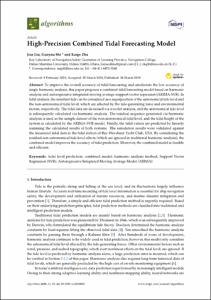High-Precision Combined Tidal Forecasting Model.

View/
Average rating
votes
Date
2019Author
Liu, Jiao
Shi, Guoyou
Zhu, Kaige
Metadata
Show full item recordAbstract
To improve the overall accuracy of tidal forecasting and ameliorate the low accuracy of
single harmonic analysis, this paper proposes a combined tidal forecasting model based on harmonic
analysis and autoregressive integrated moving average–support vector regression (ARIMA-SVR). In
tidal analysis, the resultant tide can be considered as a superposition of the astronomical tide level and
the non-astronomical tidal level, which are affected by the tide-generating force and environmental
factors, respectively. The tidal data are de-noised via wavelet analysis, and the astronomical tide level
is subsequently calculated via harmonic analysis. The residual sequence generated via harmonic
analysis is used as the sample dataset of the non-astronomical tidal level, and the tidal height of the
system is calculated by the ARIMA-SVR model. Finally, the tidal values are predicted by linearly
summing the calculated results of both systems. The simulation results were validated against
the .....
Resource URL
https://www.mdpi.com/1999-4893/12/3/65Journal
AlgorithmsVolume
12Issue
3Page Range
pp.65-81Document Language
enSustainable Development Goals (SDG)
14.aEssential Ocean Variables (EOV)
Sea surface heightDOI Original
10.3390/a12030065Citation
Liu, J., Shi, G. and Zhu, K. (2019) High-Precision Combined Tidal Forecasting Model. Algorithms. 12(3), pp.65-81. DOI: https://doi.org/10.3390/a12030065Collections
The following license files are associated with this item:
 Repository of community practices in Ocean Research, Applications and Data/Information Management
Repository of community practices in Ocean Research, Applications and Data/Information Management
